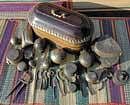

Imagine, if you will, sitting in a room and experiencing an unparalleled feeling of tranquillity, gazing with paternal tenderness at your extensive collection of Chinese miniatures. Or gold Tanjore plates. Or zwergnase dolls (whatever these are). Or out-of-circulation Walt Disney videos. Or fake Mona Lisas. Or …. The list is endless, but you get my drift?
Collectors collect a wide range of things, from the relatively common place stamps and coins to obscure and exotic things that would astonish the non-collector, such as elephant toenails, which are not, as one may imagine, collected by being intrepid enough to find a pachyderm in need of a pedicure, but a type of American knife of very early 20th century vintage (which one can buy off the Net). One can only marvel at the existence of organisations like the American Hatpin Society, Paperweight Collectors’ Association, Painted Soda Bottle Collectors’ Association or the International Society of Apple Parer Enthusiasts (if you don’t believe me that such organisations exist, ask Google!). All of these societies serve the need of collectors, and are often the repositories of astonishingly detailed information on objects that may seem prosaic to the uninitiated. Collectors can get very technical about the items they collect.
And not just that, they spend huge sums of money enhancing their collections. And when they do manage to aggressively outbid a fellow collector and acquire that much-yearned for hatpin or toothpick, they experience a feeling of great inner peace. But when they are outbid, they experience great frustration, irritation and even agitation. And at least a few times a week, they must gaze upon their precious collection, to make them feel alive again.
The type of collector I have referred to above is not to be confused with the more common variant seen today in urban India — the investment-oriented collector. For this person, the raison d'être for collecting is not so much the object itself but the cash value attached to it. Collecting is then seen as an investment that one can encash at a later time. As a result such a person would only look at high-value collectibles such as art or antiques.
This type of collector is generally looked down upon by the true collector as the commercial element is too pervasive. The true collector, on the other hand, collects for the joy of collecting. As a result, the objects collected may be relatively obscure and the choice of collectible would be a highly personal one and could have its origins in some life event or nostalgic memory of personal significance as in the case of the person who collected bottle openers of different shapes, sizes and countries of origin, for his abiding memory of his childhood was opening bottles of soda water and beer for his father.
However, the original incident or memory is only a trigger point and the focus soon shifts to the object itself and the joy that the collector feels when an exotic variation of the collectible is obtained after much effort and difficulty.
Most of us tend to collect something or the other in our lives, even if not completely consciously and sometimes when we shift residence we cannot understand for what purpose we have an impressive collection of unused shoelaces or rolls of ribbons of different colours. But this does not make us collectors, for we are not subject to the most important aspects of collecting: The joy of the hunt, the exhilaration of object ownership and the joy of seeing it regularly amongst one’s possessions. Also evident is the pain experienced by the collector when a coveted object is misplaced, carelessly handled, broken or unobtainable for whatever reason, as well as the increasing quantities of time that are devoted to the collection, even at the risk of neglecting other priority domains in the collector’s life.
Does this mean collectors are addicts, considering they appear to manifest so many symptoms of addiction? Some of them seem to feel so anyway, judging by some of the support groups they have formed: Collectors Anonymous. Doll Collectors Anonymous.
Moocollectors Anonymous (devoted to cattle lovers). Whether these function along the same lines as Alcoholics Anonymous or Narcotics Anonymous, I have no idea. But surely the choice of the word ‘anonymous’ is indicative! A diatribe against the cruelty to animals perpetrated by ‘Animal collectors’ that appeared in the May-June 1994 issue of Shelter Sense, published by The Humane Society of the United States, aggressively concludes that collectors are addicts. And they may well be right. Not your everyday numismatist or philatelist, who collects the objects of his affections more as a pastime or a hobby, but the hard core collector who needs his regular ‘fix’.
I think the key element is how much the collecting habit interferes with the rest of the collector’s life spaces. If it’s merely a personal space activity that does not detract from the time and energy invested in other relationships and spaces, then it can be an enervating activity that can genuinely recharge one’s batteries. However, if the collector spends more time, energy and money on the collection than the other life spaces are comfortable with and continues to do despite stiff protest from members in these other life spaces, then dysfunctionality has set in and intervention becomes necessary.
The mindset of a collector is best summed up in the following statement that appeared a few years ago on the website of ‘The Card Collector’s Company’: “A Card Collection is a magic carpet that takes you away from work-a-day cares to havens of relaxing quietude where you can relive the pleasures of a past time brought to life in vivid picture and prose. This is history from an original source.”
If a card collection can get you that eloquent, I’m happy for you. But if your romantic partner can’t, then we have a problem on our hands.